Creative Advertising Market Overview:
The global creative advertising market is witnessing consistent growth, driven by the increasing demand for innovative campaigns across industries such as retail, technology, entertainment, and consumer goods. This market encompasses various forms of advertising, including digital, print, out-of-home (OOH), and experiential advertising. Our report offers a comprehensive analysis of procurement trends, emphasizing cost optimization strategies and leveraging digital tools to enhance advertising processes and campaign execution.
Key future challenges in creative advertising procurement include adapting to evolving consumer preferences, managing fluctuating media costs, and integrating sustainability into campaign strategies. Digital procurement tools and data-driven approaches are critical for optimizing creative advertising processes and ensuring long-term effectiveness. As global demand for impactful advertising continues to rise, businesses are utilizing market intelligence to improve campaign outcomes and minimize risks.
The creative advertising market is projected to maintain steady growth through 2032, with key highlights including:
- Market Size: The global creative advertising market is estimated to reach USD 1,777.3 million by 2032, growing at a CAGR of approximately 7.8 % from 2024 to 2032.
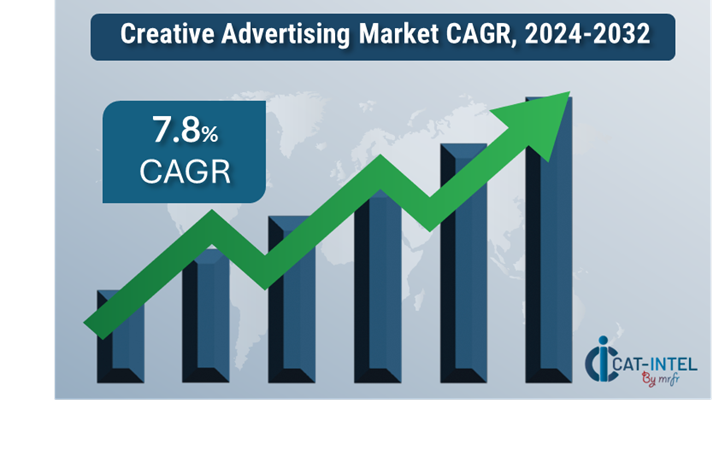
- Sector Contributions: Growth in the market is driven by:
- Digital Transformation: Increasing adoption of social media, programmatic advertising, and digital video campaigns to engage with target audiences effectively.
- Brand Differentiation Needs: Growing competition across industries pushing brands to invest in unique, impactful advertising strategies.
- Technological Innovation: Advancements in ad technology, including augmented reality (AR), virtual reality (VR), and artificial intelligence (AI), are enabling more engaging and personalized advertising experiences.
- Investment Initiatives: Companies are increasing investments in content creation, creative tools, and analytics platforms to improve campaign efficiency and audience targeting.
- Regional Insights: North America remains a key contributor due to high spending on digital advertising and the adoption of emerging technologies.
Key Trends and Sustainability Outlook:
- Personalized Advertising: Advances in data analytics are driving the demand for personalized content that resonates with specific audience segments.
- Integrated Campaigns: Growth in multi-channel campaigns that combine digital, print, and experiential elements for maximum impact.
- Focus on Sustainability: Increased emphasis on eco-friendly advertising methods, such as digital campaigns over print, and reducing carbon footprints in production.
- Creative Innovation: Rising demand for unique, cutting-edge ideas tailored to specific markets and brand objectives.
- Automation and AI Integration: Leveraging AI for real-time ad placement, performance tracking, and creative optimization.
Growth Drivers:
- Digital Media Expansion: Ongoing investments in social media platforms, OTT channels, and influencer marketing are driving the demand for innovative digital campaigns.
- Consumer Engagement Needs: Brands are prioritizing creative advertising to enhance customer engagement and loyalty.
- Technological Integration: The use of AR, VR, and AI to deliver immersive advertising experiences is fuelling market growth.
- Regulatory Standards: Compliance with advertising regulations ensures ethical practices and consumer trust.
- Sustainability Goals: Companies are adopting eco-friendly practices in advertising, including digital-first strategies and sustainable content production.
Overview of Market Intelligence Services for Creative Advertising:
Recent analyses have highlighted key challenges such as rising media costs, the increasing complexity of multi-channel campaigns, and the need for consistent branding. Market intelligence reports provide actionable insights into procurement opportunities, enabling companies to identify cost-saving measures, optimize agency partnerships, and enhance campaign effectiveness. These reports also ensure organizations maintain compliance, achieve creative excellence, and efficiently manage advertising budgets.
Procurement Intelligence for Creative Advertising: Category Management and Strategic Sourcing:
To remain competitive in the creative advertising market, businesses are optimizing procurement processes by conducting spend analysis for vendor evaluation and improving campaign efficiency through actionable market intelligence. Effective category management and strategic sourcing are essential for minimizing advertising costs and ensuring consistent delivery of high-quality campaigns. By leveraging market insights, businesses can streamline their advertising strategies and secure favorable partnerships with creative agencies.

Pricing Outlook for Creative Advertising: Spend Analysis
The pricing outlook for creative advertising is expected to remain moderately stable, with potential variations influenced by key factors. Shifts in demand for innovative advertising solutions, advancements in technology, and changes in media consumption patterns are significant drivers of price trends. Additionally, the rising demand for personalized, data-driven campaigns and sustainable advertising practices is exerting upward pressure on pricing.
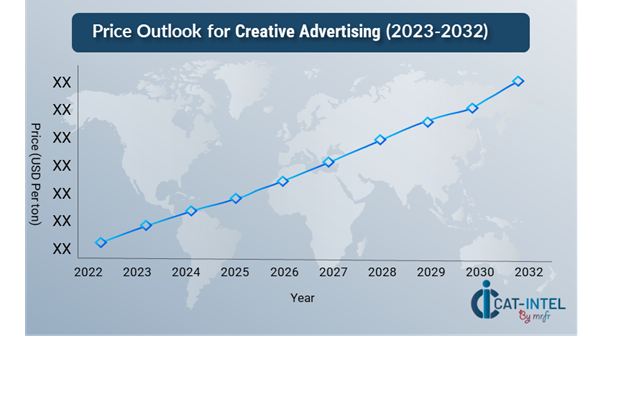
Graph shows general upward trend pricing for creative advertising and growing demand. However, there may be fluctuations influenced by economic conditions, technological advancements, and competitive dynamic.
Efforts to optimize procurement processes, strengthen agency partnerships, and adopt digital tools are essential for managing costs effectively. Leveraging real-time analytics for media pricing, automating campaign tracking, and improving resource allocation can significantly enhance cost efficiency.
Establishing fair pricing models with advertising partners, investing in scalable technologies, and focusing on high-impact creative solutions are critical strategies for managing pricing in the advertising industry. While navigating these challenges, maintaining campaign quality, meeting sustainability objectives, and incorporating technological advancements will remain vital for achieving cost control.
Cost Breakdown for Creative Advertising: Total Cost of Ownership (TCO) and Cost-Saving Opportunities
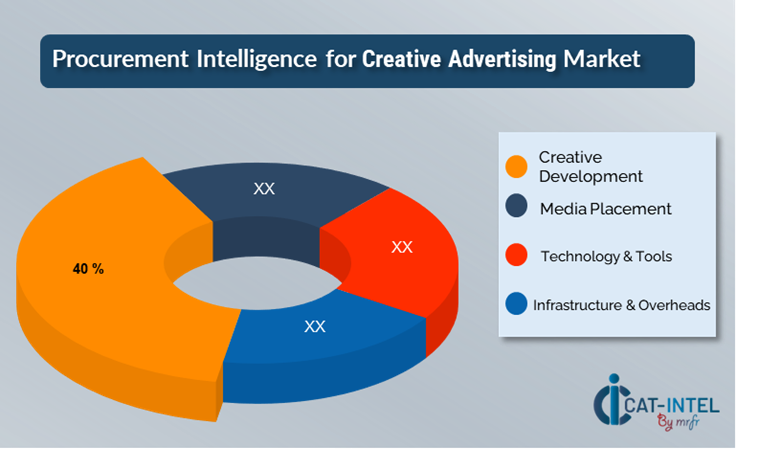
- Creative Development (40%)
- Description: A significant portion of the costs in creative advertising involves concept ideation, content creation, and production expenses, including hiring creative talent and leveraging high-end tools or studios. These costs are influenced by the complexity and scope of campaigns.
- Trends: Companies are streamlining creative processes by using in-house resources, adopting collaborative tools, and leveraging AI-driven platforms to enhance efficiency and reduce development costs. The growing demand for personalized campaigns is contributing to higher investments in creative design and innovation.
- Media Placement (XX%)
- Technology & Tools (XX%)
- Infrastructure & Overheads (XX%)
Cost-Saving Opportunities: Negotiation Levers and Purchasing Negotiation Strategies
In the creative advertising industry, optimizing procurement processes and utilizing strategic negotiation tactics can drive significant cost savings and improve operational efficiency. Establishing long-term partnerships with creative agencies, media outlets, and production houses can lead to better pricing and more favourable terms, such as discounts based on volume or long-term commitments. Bulk buying of media space and negotiated package deals also present opportunities to secure lower rates and mitigate fluctuations in advertising costs.
Collaborating with agencies that prioritize innovative solutions, data-driven strategies, and sustainability can offer additional benefits, including access to higher-quality campaigns and reduced environmental impact. Implementing digital tools for campaign management, including real-time tracking and performance analytics, can streamline processes, reduce inefficiencies, and lower overall advertising costs. Diversifying agency partnerships and employing a multi-vendor strategy can help mitigate risks, such as shifts in media trends or production disruptions, and increase leverage during negotiations.

Supply and Demand Overview for Creative Advertising: Demand-Supply Dynamics and Buyer Intelligence for Effective Supplier Relationship Management (SRM)
The creative advertising industry is experiencing steady growth, driven by increased demand for targeted, personalized campaigns across industries like retail, entertainment, and tech. The balance between supply and demand is influenced by several factors, including technological advancements, shifts in consumer behaviour, and evolving media consumption patterns.
Demand Factors:
- Targeted Advertising: The growing need for personalized advertising, fueled by data analytics and AI, is driving demand for high-quality, tailored ad solutions.
- Sustainability and Ethical Advertising: Increasing consumer preference for socially responsible and sustainable advertising is prompting brands to adopt eco-friendly media practices.
- Digital Transformation: The rise of digital media platforms and social media channels is increasing the demand for agile, digital-first campaigns.
- Customization of Campaigns: The push for campaigns tailored to specific demographics or micro-markets is encouraging agencies to offer more bespoke creative solutions.
Supply Factors:
- Technological Innovations: Advancements in creative tools, AI, and automation are enabling more efficient content production and campaign management, enhancing supply capabilities.
- Media Landscape Evolution: Changes in media consumption patterns, such as shifts towards digital and mobile, impact the supply of advertising channels and opportunities.
- Cost of Media Space: The availability and cost of ad space across different platforms fluctuate, influenced by factors like demand, seasonality, and platform popularity.
- Agency Resources and Capabilities: The ability of creative agencies to scale production and meet diverse client demands, especially in terms of delivering high-quality and innovative campaigns, is a key determinant in supply stability.
Regional Demand-Supply Outlook: Creative Advertising
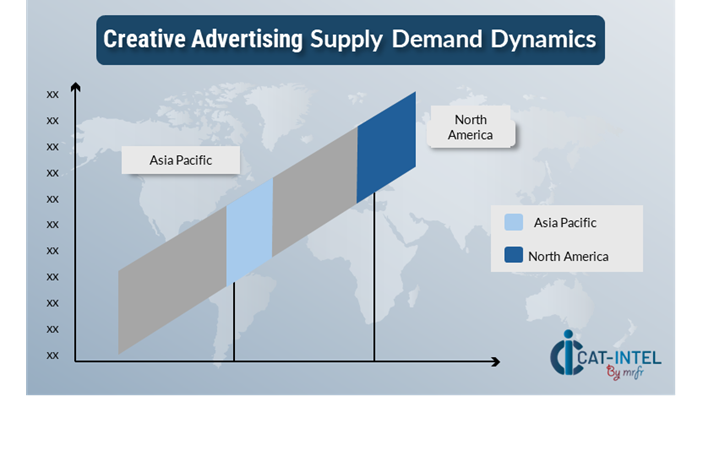
The Image shows growing demand for creative Advertising in North America both Asia Pacific and, with potential price increases and increased Competition.
North America: Dominance in the Creative Advertising Sector
North America, particularly the United States and Canada, remains a dominant force in the global creative advertising market, driven by several factors:
- High Advertising Spend: The region continues to be a major hub for advertising budgets, particularly in the digital space, which fosters competition among brands and media companies.
- Media Diversity: The variety of media outlets, from traditional TV to digital platforms, provides diverse opportunities for advertisers to reach different consumer segments.
- Technological Leadership: North America leads in the adoption of new advertising technologies, such as programmatic advertising, AI-driven campaign tools, and advanced analytics.
- Consumer-Centric Advertising: The increasing focus on consumer-centric, data-driven advertising strategies continues to shape demand for more personalized campaigns, creating new opportunities for innovation.
- Sustainability Push: In line with global trends, advertisers in North America are embracing sustainable advertising practices, focusing on reducing waste, energy consumption, and using ethical production methods.
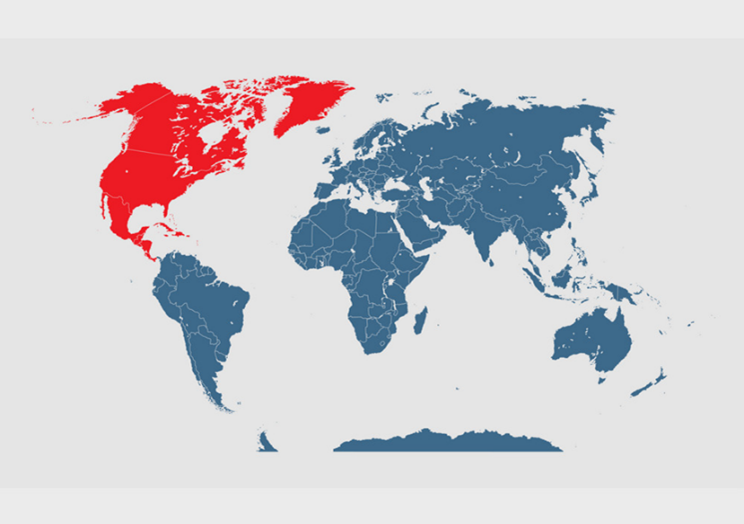
North America Remains a key hub Creative Advertising Price Drivers Innovation and Growth.
Supplier Landscape: Supplier Negotiations and Strategies:
The supplier landscape in the creative advertising market is dynamic and competitive, with both global agencies and regional firms playing significant roles in shaping the industry. Suppliers influence critical aspects such as pricing, service offerings, innovation, and campaign quality. The market is led by globally recognized advertising agencies while smaller, boutique firms focus on providing specialized services such as niche marketing strategies, localized content, or cutting-edge digital solutions.
The creative advertising supplier ecosystem, particularly in major markets like North America, Europe, and Asia Pacific, consists of well-established industry leaders and emerging innovators catering to diverse client needs. As the demand for creative and targeted advertising continues to grow, suppliers are prioritizing advancements in technology, expanding their service portfolios, and adopting sustainable practices to deliver high-quality and impactful campaigns at competitive prices.
Key Suppliers in the Creative Advertising Market Include:
- WPP Group
- Omnicom Group
- Publicis Groupe
- Dentsu International
- Interpublic Group (IPG)
- Accenture Interactive
- BBDO Worldwide
- Leo Burnett Company
- Havas Creative
- Grey Group
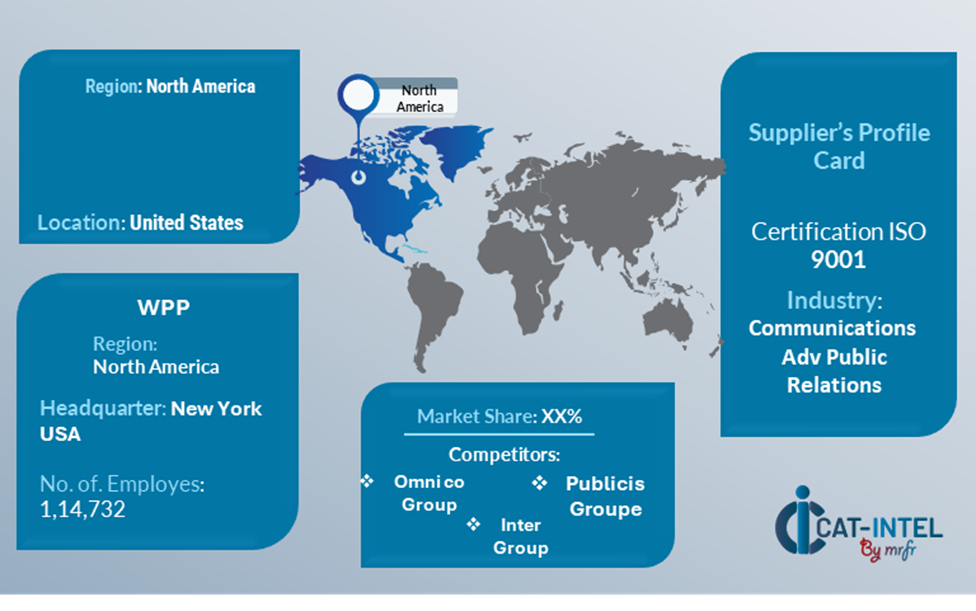
Key Developments Procurement Category Significant Development:
|
Significant Development |
Description |
|
Market Growth |
The creative advertising industry is expanding, driven by increasing investments in digital platforms, personalized campaigns, and the growing importance of brand storytelling, particularly in emerging markets. |
|
Sustainability Focus |
There is a growing emphasis on sustainable advertising practices, with brands prioritizing eco-friendly campaigns, digital-first strategies, and reduced reliance on traditional print media. |
|
Content Innovation |
Advertising agencies are diversifying their offerings by creating immersive experiences, leveraging cutting-edge technologies like AR, VR, and interactive content to engage audiences more effectively. |
|
Technological Advancements |
The integration of AI, programmatic advertising, and advanced analytics is revolutionizing campaign strategies, enabling real-time optimization and improved targeting precision. |
|
Global Trade Dynamics |
Fluctuations in global advertising regulations and data privacy laws are reshaping campaign execution, influencing market accessibility, and compliance strategies in various regions. |
|
Customization Trends |
There is a rising demand for highly tailored advertising solutions that align with industry-specific needs, cultural nuances, and local market preferences to enhance relevance and impact. |
|
Creative Advertising Attribute/Metric |
Details |
|
Market Sizing |
The global creative advertising market is estimated to reach USD 1,777.3 million by 2032, growing at a CAGR of approximately 7.8 % from 2024 to 2032. |
|
Advertising Technology Adoption Rate |
Around 60% of advertising agencies are adopting advanced technologies, such as AI-driven analytics, programmatic advertising, and immersive tools like AR/VR for enhanced campaign effectiveness. |
|
Top Creative Advertising Strategies for 2024 |
Key strategies include leveraging data-driven insights, prioritizing personalized campaigns, enhancing digital presence, and integrating sustainable advertising practices. |
|
Creative Process Automation |
Approximately 40% of creative agencies have implemented automation tools for tasks such as ad placement, campaign analytics, and content creation to improve efficiency and reduce costs. |
|
Creative Process Challenges |
Major challenges include adapting to evolving consumer behavior, managing data privacy compliance, addressing market saturation, and staying competitive in a fast-changing digital landscape. |
|
Key Agencies |
Leading agencies in the creative advertising market include WPP Group, Omnicom Group, and Publicis Groupe, offering diverse advertising solutions tailored to various industries. |
|
Key Regions Covered |
Prominent regions in the creative advertising market include North America, Europe, and Asia-Pacific, with growing demand in sectors such as technology, consumer goods, and retail. |
|
Market Drivers and Trends |
Growth is driven by increasing digital media consumption, the rise of personalized and immersive advertising formats, advancements in AI and data analytics, and a shift toward sustainable and socially responsible campaigns. |
Frequently Asked Questions (FAQ):
A1: Our strategic consulting services provide in-depth insights into the creative advertising landscape, analysing market trends and identifying leading agencies. We offer campaign optimization, competitor analysis, and tailored strategies to enhance the impact of your advertising efforts.
A2: We assist in evaluating the TCO for creative advertising by assessing expenses related to campaign development, production, distribution, and technology adoption. This analysis ensures you understand the full financial scope of your advertising initiatives.
A3: We provide solutions to manage risks such as budget overruns, ineffective campaigns, and data privacy issues. These strategies ensure cost-effective, compliant, and high-performing advertising campaigns.
A4: Our Agency Relationship Management (ARM) services help establish collaborative partnerships with advertising firms. We support contract negotiations, performance evaluations, and seamless integration into your marketing ecosystem.
A5: We recommend best practices like audience segmentation, leveraging data analytics, implementing quality control measures, and monitoring campaign performance to achieve measurable results and improve ROI.
A6: Digital tools streamline advertising processes by enabling real-time campaign monitoring, automating ad placements, and improving audience targeting. These tools boost efficiency and campaign effectiveness.
A7: Our performance management services track key metrics such as campaign reach, audience engagement, and conversion rates. This helps refine advertising strategies and maximize impact.
A8: We assist in negotiations by benchmarking agency fees, exploring performance-based pricing models, and securing flexible contract terms to ensure value-driven partnerships.
A9: We offer market analysis tools that provide insights into advertising trends, competitor campaigns, and audience behaviour. These tools support data-driven decision-making for advertising strategies.
A10: We guide you in adhering to regulatory and internal compliance standards, ensuring campaigns meet ethical guidelines, data privacy laws, and advertising regulations.
A11: We recommend strategies like diversifying media channels, maintaining a flexible budget, and preparing contingency plans to ensure campaigns remain effective despite unforeseen challenges.
A12: Our tracking solutions monitor metrics such as campaign effectiveness, delivery timelines, and innovation in strategies. This helps evaluate agency reliability and supports long-term decision-making.
A13: We help identify eco-conscious practices, such as minimizing print media, using renewable resources in production, and promoting ethical storytelling. These align your campaigns with sustainability goals.
A14: Our pricing analysis benchmarks agency costs, evaluates market trends, and employs negotiation strategies to secure effective advertising solutions while ensuring high-quality and impactful campaigns.











